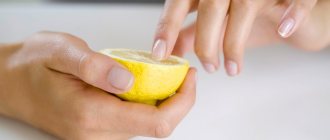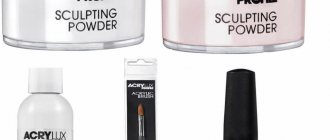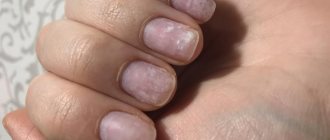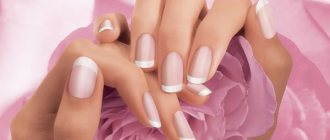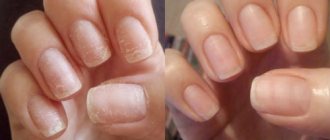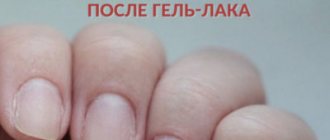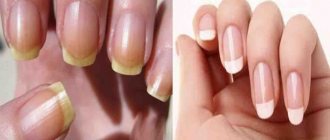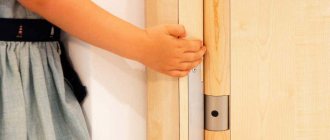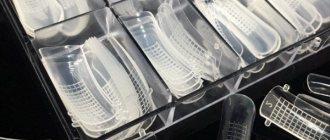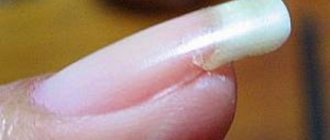An impeccable manicure is an integral part of every woman’s image. It is almost impossible to hide a bad manicure or its absence. Nail extensions are very convenient and practical! Imagine that your favorite French manicure will delight you not for 3-4 days, but for three whole weeks! By nature, each person is unique: hair has a certain structure, skin type is strictly individual.
And nails differ in their structure, shape, and quite often their appearance does not satisfy their owners. In this case, nail extensions with gel or acrylic can come to the rescue.
Let's look at each of them separately, how they differ, and what are the advantages of one method or another.
Look at all Nail extensions photos
Nail extensions - history
How did it all begin? The first women who decided to wear artificial nails were Hollywood actresses Greta Garbo and Marlene Dietrich. Stars who shine on television are simply obliged to look perfect, but famous divas could not boast of good nails, so they came up with a great idea - to make them false.
Greta Garbo made them from the first available material - film. She pasted them on her nails, which immediately changed - they became beautiful and spectacular.
But they didn’t last long - after a couple of hours they fell. But the game was worth the candle, and over the next few decades, many women used this method of transforming their manicure.
Only one desire seemed unrealizable so far: that they serve for a long time. But in our time this is already a problem, we can even choose our nail extensions from different materials, the most popular of which are acrylic and gel.
The desire to be loved, desired and an object of admiration is natural for any representative of the fair sex. Of course, in achieving this goal, many believe that attractive appearance should play a significant role.
At the same time, there is hardly a single woman on earth whose natural characteristics would fully correspond to certain abstract “ideal” standards, replicated by the media and capturing the minds of women. Many women, looking at the covers of fashion magazines, from which impeccable (and thoroughly “photoshopped”) “beauty queens” bestow their slightly arrogant smiles on them, earn in this regard a real inferiority complex and uncertainty about the power of their charm. Sometimes they are ready to give everything in order to get even one iota closer to the ideal of beauty that, in their opinion, is infinitely far from them.
Where there is demand, there will be supply. The modern beauty industry declares its ability to correct the “unfortunate mistakes” of nature. The problem of small breasts or loose skin can be solved using plastic surgery methods, and faded hair color can be solved with suitable dye. . . In a word, where it is impossible to achieve anything with the ordinary use of special cosmetics, masking of external imperfections is used. In addition, it is always easier to go this way, because in this case “tuning” takes less time than using conservative methods.
One of these ways to solve problems with imperfect appearance is nail extensions. Brittle, dull, short nail plates after one or two hours in the manicure salon turn into beautiful, shiny, long, with slightly pointed ends - exactly the way a woman sees them in her own dreams. Moreover, hands with similar “claws” look much more elegant and neat.
However, buying into such a beautiful “cover”, a woman who wants to undergo such a procedure does not always think about what consequences this threatens her in the future. Not every master will warn you about what nails experience after extensions, what changes (in some cases irreversible) occur to them. Specialists working in beauty salons always assure their clients that such a procedure is safe - they say that if all technologies are followed, there will be no harm to the nail plates. However, in this case, they are very cunning and keep things back.
To begin with, it’s worth saying that any manipulation of this kind is a huge stress for the nails. In this regard, it is worth remembering at least that part of the procedure that immediately precedes the application of artificial material (acrylic or gel). Usually in such cases, the woman’s own nail plates are filed down. Although manicurists assure that cutting off a couple of keratin layers (there are about a hundred of them on each nail) will not cause significant harm, still too much depends on the qualifications of the specialist. There are often cases when, in this way, a lover of nail extensions actually lost her own.
One of the possible troubles in this case is dystrophy of the nail plate. This pathology occurs for many reasons, and rough mechanical impact and trauma to the keratin layers are far from the least on their list. As “aggravating circumstances” for the manifestation of this disease, it is worth adding the violation of natural hygiene, blood circulation and nutrition of the nails (which, by the way, causes them to thin out and become quite brittle).
The risk increases many times if, wanting to save money on nail extensions, a woman applied for such a service at the first salon she came across, without bothering to find out the qualifications of the specialists working there, to find out information about the quality of their work (at least from the reviews of other clients) and materials used for this. Many cheap compounds are extremely toxic, which can negatively affect not only the nails themselves, but also the health of the body as a whole. The price for the desire to have “beautiful” hands is too high!
Dystrophy has a destructive effect on the stratum corneum, and in severe cases of its manifestation, the lady risks losing the natural keratin “decoration” of her fingers. The disease itself will not go away; in the absence of adequate treatment, it only leads to a worsening of the situation. Therefore, when it appears (“alarm signal” should be longitudinal or transverse grooves on the horny plates), it is necessary to urgently seek medical help.
However, the possible harm from nail extensions is not limited to the risk of dystrophy. Allergies should be added to the list of such troubles. True, manicurists assure that it can be avoided if you do not allow the extension material to get on the skin or any other tissues of the body, with the exception of the nail plates themselves. You also need to remember that a self-respecting beauty salon must have a well-equipped ventilation system - thus, not only the professionals, but also their clients will have to inhale harmful fumes from the materials used in certain manipulations to a minimum.
When you decide to get nail extensions, you shouldn’t forget about the likelihood of fungal diseases appearing on them. If the technology of this procedure is not followed, a greenhouse effect is created under the artificial turf - a very favorable environment for the growth of fungi and mold. A nail affected by any of them begins to crumble, break, turn yellow or blacken. All this usually leads to its loss.
In any case, even before visiting a nail salon, you should first visit a dermatologist and get his recommendations regarding extensions. Often in such conversations, a woman learns that for a number of diseases such a procedure is extremely undesirable at all.
Even if there are no contraindications, nail extensions cannot be done constantly. At least once a year, you should give your natural horny plates a “break” for at least 3-4 weeks, all the while taking care of their nutrition and health.
Gel nail extensions
Artificial gel nails are produced by applying a special softened gel, which hardens after a short drying under a UV lamp.
A huge advantage of gel nails is that they can “breathe” and allow moisture to pass through, which makes them closer to natural, which is very desirable.
Even in appearance they are very similar, so it is not necessary to paint them with varnish. Drying the gel under UV will prevent the penetration of various fungi.
They adhere firmly to the base and are quite strong. Of course, your natural nails continue to grow under the gel layer, therefore, after a few weeks you will need a manicure correction.
In general, gel nails can last up to 4 months, subject to proper care and timely correction in the salon.
Features of proper care for gel nail extensions
- Household chores (cooking, laundry, mopping, etc.) should only be done with gloves, otherwise you risk being left without extended nails, because they are quite susceptible to the action of acids and alkalis.
- The varnish should only be removed using a liquid that does not contain acetone.
- After the procedure, you should not immediately begin performing any work. Let them dry.
- Forget about ordinary files and sanders, giving preference to gentle ones.
- Please note that extensions should only be applied to a healthy nail plate, otherwise you can only aggravate the situation and simply lose them.
Step-by-step instruction
Step-by-step instructions with photos for gel nail extensions recommend starting with a regular manicure. All nails should be the same shape and length, the polish should be removed from them, the cuticle should be pushed back with an orange stick or a special spatula. Now you need to polish the nail coating with a buff, using a brush to remove dust.
When applying nail extensions using tips, the step-by-step instructions recommend degreasing your nails with a primer or other product, using lint-free wipes or a brush.
After carrying out such a procedure, it is forbidden to apply cream to your hands or wash them - now your nails should not come into contact with anything other than the materials necessary for extensions.
If you are extending your nails using forms, then each of them should be carefully but tightly bent to the nail so that it holds well and does not fall off.
So, the preparatory work is completed. Now let's get started with nail extensions using gel. The step-by-step instructions suggest applying the ultraviolet gel as the next step.
It should be applied in small portions, starting from the base of the nail plate, distributing it evenly along the entire length of the nail. Next, you need to dry your nails under a special lamp and reapply the gel. This time the gel is applied to the required length of the nails being extended. To obtain the same length of all nails, it is recommended to use special marks made on disposable forms. The gel applied along the entire length is dried again using an ultraviolet lamp.
After all the nails are done and well dried, you need to carefully remove the paper forms, being careful not to damage the new coating. Next, using a nail file, the shape of the nail is adjusted. That's all, actually - nail extension using gel is completed. This step-by-step instruction will help every girl, even those inexperienced in matters of nail art, to do a proper and beautiful manicure on their own.
Using gel for nail extensions allows you to even out the surface, giving the nail a beautiful shine without causing irritation to the skin around the nail and cuticle. The technology of creating false nails at home allows you to get beautiful nails that look like natural ones, spending a few hours on it. How to do gel nail extensions, step-by-step instructions with photos will help you figure it out.
Gel nail extensions photo
Acrylic nail extensions
Probably no one realizes, but acrylic is used in medical practice. Thanks to him, beauties from all over the world can bring to life all kinds of manicure options that only a person’s imagination is capable of. But at the same time, acrylic is a mandatory attribute of dental practice.
Hundreds of thousands of women should be grateful to the American dentist who, having damaged his nail plate, thought of applying a piece of acrylic to the site of the damage, which he used in dental treatment.
The resulting effect impressed the dentist so much that, when he came home, he repeated the procedure on his wife’s nails. And after 5 years he became the director of a thriving company for the production of artificial nails.
In general, acrylic, before it is transformed into a stylish manicure, is a finely ground powder, which later, after adding liquid, thickens and then hardens, taking on a familiar look to everyone.
Acrylic application methods
There are only two of them:
• On forms, when a special base is fixed, with the help of which a certain length and shape are formed. After the acrylic coating has dried, the mold is removed, the nail plate is adjusted with a grinder and a protective coating is applied.
• On tips. In this case, a tip is glued to one third of the nail, the edges of the joint are smoothed with a file, and acrylic is applied on top. After it hardens, it is fixed with a protective coating.
After some time, you may need to adjust your manicure. In this case, you will have to contact the specialist again.
Main stages
Nail extension with glue powder is carried out in 3 main stages.
- At the first stage of the extension, the master prepares the nails by attaching tips (artificial nails) to them. It should be noted that this manicure technology always involves the use of tips; it is not performed on natural nails.
- The second stage of the manicure involves applying special glue to the tips and dipping the nail plate into powder. This action must be repeated several times until the nail acquires sufficient density, after which an activator should be applied to its surface, which will fix the layers of powder, while making the nail smooth.
- At the final stage, the master carefully adjusts the shape of the nail plate and files off excess powder.
After completing these three steps, you can begin drawing.
Nail extensions with fabric allow you to extend nails of various shapes and lengths with flax, silk or fiberglass (fabric that looks like silk and is made from fiberglass).
The principle of the technique lies in the fact that a tip (plastic nail) is glued onto your own nails, onto which layers of fabric are glued.
How to remove acrylic nails?
You can easily do this yourself:
1. First, cut the ends with wire cutters, leaving 1-2 mm free.
2. Using a rough file, we process the remaining surface of the nail plate to get rid of the top fixing layer. This work is labor-intensive, because The layer is quite strong.
3. For this stage you will need a special liquid for removing acrylic nails, and if you don’t have it, then you can get by with regular nail polish remover with acetone and rectangles of foil.
4. We treat each finger with liquid and wrap it in foil. Count down 40 minutes and remove the foil. The acrylic should soften during this time, and before it hardens, remove the acrylic from the nail plates.
Don't forget to wash your hands and use hand cream.
Due to their strength, transparent texture and weightlessness, artificial acrylic nails are wildly popular among the fair sex.
general information
The combination of acrylic and gel has been used by craftsmen for a long time, because the chemical basis of these two materials is completely identical, they are both polymer. The main thing in this case is adhesion to the nail plate (of one or another material).
And the combination of different materials affects the quality of the finished nail.
If you like gel nail modeling (or it is used because of problem nails), but you want to do acrylic modeling, then the master lays out the gel base and the nail plate. In this case, the background can be made of acrylic, after which acrylic modeling is added and the nail is sealed with gel or acrylic.
In this case, nail crimping is mandatory.
The same sequence of work is used when creating a French manicure - in any type of combination, the materials will interact perfectly with each other.
